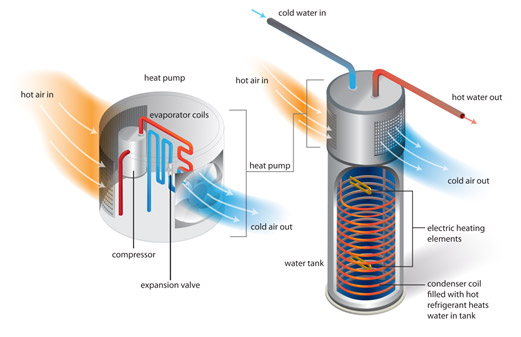Water heating represents a big slice of the home energy use pie. As the housing industry moves away from fossil methane (natural gas), it’s essential to heat water as efficiently and economically as possible. The best water heating choice for getting your home on the path to becoming an energy efficient home is to install a heat pump water heater (HPWH). Here’s how to select, locate, install and operate one.
Efficiency
Modern HPWHs are about 300% efficient, meaning that for every unit of electricity consumed, three units of hot water are produced. The basic idea behind these extremely efficient water heaters has been commercially available for more than 100 years and is the same technology used in today’s household refrigerators.
Fossil methane is commonly used for water heating due to its low cost. While gas water heaters rely on less expensive fuel, a typical gas-fired tank is only 60% efficient and the most efficient tankless model tops out around 98% efficiency. At this stage in the evolution of energy efficient homes both tank-style and tankless gas water heaters should be off the table entirely for three reasons. First, natural gas is a fossil fuel that leads to even greater greenhouse gas emissions than are produced from burning coal. Second, heating water with a super-efficient HPWH has a lower life-cycle cost than heating with fossil methane. Third, building natural gas infrastructure into new housing developments and in new homes is an unnecessary expense. HPWH will serve this function without the added expense. It’s time to move past natural gas.
How HPWHs Work
A heat pump uses a refrigerant gas to capture heat from surrounding air. A compressor increases the pressure and temperature so that the gas condenses and releases its heat. This process cools the air around the water heater while pumping heat into the tank of water. As a result the space around the HPWH will be cooled and the air dehumidified as the water is heated.

Image: USDOE
Equipment Selection
Modern HPWHs have benefited from many years of research and development. All major water heater manufacturers now offer them with warranty periods of 6 to 12 years. Reliability has been quite good. Most products are called “hybrid” water heaters to reflect that all HPWHs also contain electric resistance elements as a supplementary heat source. Consumers can choose to operate them strictly with the heat pump or in combination with the resistance element.
In warm climates, just about any model of HPWH will work fine. These are called Tier 1 models. However, in colder climates, it’s important to select a Tier 3 model designed to operate efficiently at lower temperatures. Here’s a list showing the Tier 3 HPWH models appropriate for cold climates. Efficiency is expressed as the Uniform Energy Factor or UEF with higher numbers being better.
Tank Size
Rapid temperature recovery is important for all water heaters because as hot water is drawn it’s replaced in the tank by colder water. Heat pumps definitely take longer than standard electric water heaters to reheat the water, so HPHW tank size is important. Larger tanks help compensate for slower recovery. Since hot water demand is a function of how many people are served, select a tank capacity based on the number of people in the household. A 50-gallon model is sufficient for 2-3 people. Households of more than 4 will need an 80-gallon unit.
Space
HPWHs need generous space for airflow and can’t be tucked into a small closet like standard electric water heaters. Generally, HPWHs need about 1,000 cu. ft. of space which would be, for example, an 11 ft. x 11 ft. room with an 8 ft. ceiling. Specific manufacturers may have slightly lower requirements, but generally speaking more free air volume around the unit is better. Ceiling height is also a consideration, because HPWHs tend to be taller than other water heaters due to the compressor and fan mounted on top of the tank.
Location
The fact that a HPWH draws heat from its surrounding air leads to several important considerations for where to locate the unit. All HPWHs remove moisture from the air and produce a condensate. This water must be piped to a drain of some kind. A utility sink or floor drain are ideal. If an appropriate trapped drain is located farther away from the HPWH’s location, a condensate pump may be used to reach it
In climates that need a lot of cooling, a HPWH can be located in an indoor space that will benefit from the cool, dry air. In climates where homes need more space heating than cooling, HPWHs should be located in areas that are not heated directly but stay warmer than outside. The space must remain within the HPWHs operating temperature range of about 40°F to 90°F. Noise from the HPWH’s compressor motor and a fan is also a consideration. A location near bedrooms would not be a good choice.Taking all of these factors into account, a good location for colder climates would be a basement or garage that is insulated, but not heated directly, or possibly an indoor utility or laundry room.
Ducting
HPWHs have some requirements for space, air flow, air temperature and noise management that don’t apply to conventional water heaters. Many or all these limitations can be sidestepped by using ducts to supply air to the unit and/or to exhaust air out of the house. All HPWHs offer optional duct kits that allow standard HVAC ducting to be attached. This opens a range of possibilities.
For example, the HPWH could be located in a small interior mechanical room or closet. A supply duct could draw air from outside in mild climates. In cooler climates, supply air may originate in a tempered space, such as a crawlspace, basement, or garage. Similarly, the cold exhaust could be directed through a duct to the outside — or in warm climates to an area where cooling is desirable. This arrangement allows the tank to be centrally located without reducing comfort or increasing space heating energy use.
Financial Factors
According to the the US Department of Energy, a typical household could save as much as $3750 over the 13-year life of a heat pump water heater compared to a standard electric model. This figure is based on national averages and may vary significantly depending on specific situations. In the process of designing a zero energy home, an energy model will give a much more accurate prediction of savings and how a HPWH meshes with other energy efficiency features. Many utility programs offer incentives for HPWHs – so check with your utility for details. They may require product and installation specifications.
Operation
Basic operation of a HPWH is not only easy, but may offer features that are more convenient than most standard water heaters. You can set the operating mode to “Hybrid” and walk away. This setting will ensure the high efficiency heat pump provides hot water whenever possible. When high hot water demand exceeds the capability of the heat pump, the built-in electric element kicks in to meet the need. Many HPWHs offer other helpful options, such as a convenient digital interface for setting water temperature, a mode called “Electric” or “High Demand” that locks out the heat pump and forces the electric element to do all the work, a “Vacation” mode that reduces energy use during long absences and triggers the water heater to resume normal operations on a specific day, and a control interface that allows the household to participate in a utility demand response program that reduces water heating operation during certain time periods in exchange for favorable electricity rates.
Hot water is an essential part of modern life but also a major contributor to residential energy use and carbon emissions. Installing a HPWH is a step in the right direction toward getting an efficient home on the path to zero energy.


Erika Brady says:
I like that you explain how modern heat pump water heaters have an electric supplementary heat source, which is why they’re a hybrid option. If someone is looking for one, it would probably be a good idea to research different makes and models online. This could give you the chance to learn about their reliability and different factors like the size in order to determine which one would be best for the amount of hot water you need in your home.
Burnice Bauch says:
This article on making hot water the modern, energy-efficient way is enlightening! The discussion on heat pump water heaters and solar thermal systems showcases innovative solutions. Thanks for sharing this valuable resource for energy-conscious individuals!
best dog training in austin says:
Having recently transitioned to a heat pump water heater (HPWH) in my own home, I can attest to the numerous advantages outlined in this blog post. The efficiency alone was a game-changer for me, not to mention the reduced carbon footprint. The blog provides a comprehensive guide for anyone considering an HPWH, with practical advice on equipment selection, tank size, and ideal placement. This post is a great resource for those looking to make an eco-friendly switch.